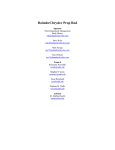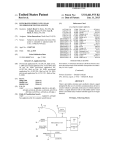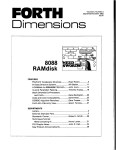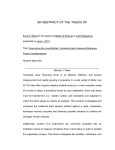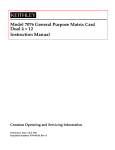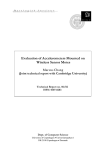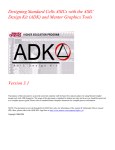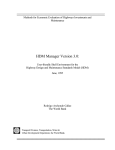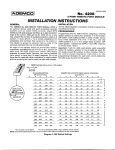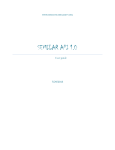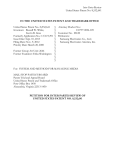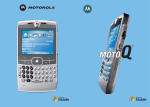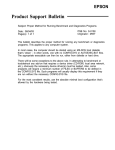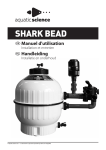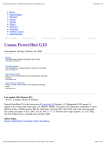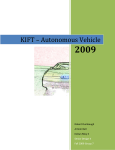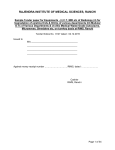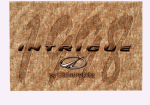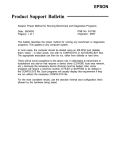Download Eyeglasses with a heart rate monitor
Transcript
US007677723B2 (12) Ulllted States Patent (10) Patent N0.: Howell et al. US 7,677,723 B2 (45) Date of Patent: Mar. 16, 2010 (54) EYEGLASSES WITH A HEART RATE MONITOR 2,638,532 A 2,794,085 A 5/1953 Brady 5/1957 De Angells (75) Inventors: Thomas A. Howell, Palo Alto, CA (US); David Chao, Saratoga, CA (US); C. 2318511 A 2’830’132 A 12/1957 Ullery et 31' 4/1958 Borg Douglass Thomas, Campbell, CA (US); Robert Grant Day, San Francisco, CA (US); Peter P. Tong, Mountain V1eW, CA _ (Us) (Cont1nued) (73) Assignee: IpVenture, Inc., Los Altos, CA (US) (*) Notice: Subject to any disclaimer, the term of this patent is extended or adjusted under 35 FOREIGN PATENT DOCUMENTS CN 88203065 11/1988 USC 154(b) by 288 days. (21) Appl. No.: 11/650,626 (Cont1nued) OTHER PUBLICATIONS (22) Filed: Jan. 6, 2007 “:1.5g Dual Axis Micromachined Accelerometer”, Freescale Semi (65) Prior Publication Data Us 2007/0109491 A1 May 17, 2007 conductor, lnc., Motorola Semiconductor Technical Data, MMA6260Q, 2004,14’ H Related US. Application Data (60) Provisional application No. 60/787,850, ?led on Apr. 1, 2006, provisional application No. 60/846,150, ?led on Sep. 20, 2006, provisional application No. 60/763, (Cont1nued) Primary ExamineriHuy K Mai (57) ABSTRACT 854, ?led on Jan. 30, 2006. (51) Int_ CL A pair of glasses With a heart-rate monitor according to one ( 200601 ) embodiment. The heart-rate monitor is con? gured to measure US. Cl. ....................................... .. 351/158-, 351/41 Field of Classi?cation Search ................. .. 351/41, the heart rate Ofthe user ofthe g lasses. The heart-rate monitor can include a Sensor With a radiation transmitter and a radia 3 51 / 136, 158; 607/9, 14, 18 tion receiver. The radiation could be infrared radiation. In one G02C 1/00 ( 52 ) (58) See application ?le for complete Search history, (56) R f Ct d e erences 1 e U.S. PATENT DOCUMENTS 320,558 669,949 1,255,265 1,917,745 2,249,572 A A A A A 6/1885 3/1901 2/1918 7/1933 7/1941 Hull Underwood Zachara Weiss Lieber approach, the receiver measures signals transmitted by the transmitter through a body part of the user to measure the user’ s heart rate. The sensor could be incorporated in a clip to clip onto the body part of the user, such as the ear lobe of the user. In another approach, the receiver measures signals trans mitted by the transmitter and re?ected by a body part of the user to measure the user’s heart rate. 26 Claims, 9 Drawing Sheets US 7,677,723 B2 Page2 2,904,670 3,060,308 3,597,054 3,710,115 4,165,487 U.S. PATENT DOCUMENTS 6,061,580 A 6,091,546 A A A A A A 6,091,832 6,115,177 6,132,681 6,154,552 6,176,576 9/1959 10/1962 8/1971 l/1973 8/1979 Calmes Forfuna Win18r Jubb Corderman A A A A B1 4,254,451 A 3/1981 Cochran/1L 6,225,897 B1 4,283,127 4,322,585 4,348,664 4,389,217 4,526,473 4,535,244 4,608,492 4,683,587 4,751,691 8/1981 3/1982 9/1982 6/1983 7/1985 8/1985 8/1986 7/1987 6/1988 6,231,181 6,236,969 6,243,578 6,259,367 6,270,466 6,292,213 6,301,367 6,307,526 6,343,858 A A A A A A A A A 4,757,714 A 4,773,095 4,806,011 4,822,160 4,822,161 4,851,686 4,942,629 4962469 4,985,632 5,008,548 A A A A A A A A A Rosenwinkeletal. Liautaud Boschettiet al. Baughman et al. Zahmlll Burnham Burnham Silverman Perera 7/1988 PuIdyetaL 9/1988 2/1989 4/1989 4/1989 7/1989 7/1990 10/1990 1/1991 4/1991 5/2000 A1166111116161. 7/2000 sp11Z61 7/2000 9/2000 10/2000 11/2000 1/2001 5/2001 D6y16 6161. B1 B1 B1 B1 B1 B1 B1 B1 B1 5/2001 5/2001 6/2001 7/2001 8/2001 9/2001 10/2001 10/2001 2/2002 6,349,001 B1 2/2002 6,349,422 6,409,338 6,426,719 6,431,705 6,478,736 6,506,142 6,513,532 6,517,203 6,539,336 Shannon 6,542,081 B2* 4/2003 6,546,101 B1 6,554,763 B1 4/2003 M11116y6161. 4/2003 A1116116 6161. 5/1991 5,036,311 A 5,050,150 A 7/1991 Moran @191 9/1991 Ikeda 2/2002 6/2002 7/2002 8/2002 11/2002 1/2003 2/2003 Swab Rupp6116161. Koike Klein W6111s161116161. Jones B6yd6116161. Mann zelman sp11Z61 s61116g616161. J6w611 N6g616d6 6161. L111d611 M61111 116116161. M611116161. ZWiCkPr er 91 Bertinger Tsai Jimmy Pearson Stadlmann 01199191 Bianco et al. Gar 5,020,150 A B1 B1 B1 B1 B1 B2 B2 B1 B1 s111111116116161. VOSSlef B61611 6161. K6161j6w 6161. 6166116161. 2/2003 Blumet 31, 3/2003 VOCk 6161. 161611 ....................... .. 340/575 5,093,576 A 3/1992 Edmond et a1. 6,619,799 B1 9/2003 Blum et 31, 5,148,023 A 5,151,600 A 5,161,250 A 9/1992 Hayashiet al. 9/1992 B111Ck 11/1992 16111121 9191 6,629,076 B1 6,721,962 B1 6,729,726 B2 9/2003 Haken 4/2004 P616116 5/2004 M111616161. 5,172,256 A 5,306,917 A 12/1992 Sethofer et al. 4/1994 Black et a1. 5,353,378 5359370 5,367,345 5,379,464 5,382,986 5,394,005 5,452,480 5,455,640 5,457,751 5,500,532 D369,167 5,510,981 5,513,384 5,533,130 5,581,090 5,585,871 5,589,398 5,590,417 5,608,808 5,634,201 5,673,692 5,686,727 5,715,323 5,737,436 5,900,720 10/1994 Hoffman etal. 10/1994 Mugnier 6,736,759 B1 6,764,194 B1 6,792,401 B1 5/2004 Stubbs et a1‘ 7/2004 Cooper 9/2004 Nigro etal, 6,912,386 B1 6/2005 1111111561g 6161. A A A A A A A A A A S A A A A A A A A A A A A A A 5,941,837 A 5,946,071 A 11/1994 1/1995 1/1995 2/1995 9/1995 10/1995 10/1995 3/1996 4/1996 4/1996 4/1996 7/1996 12/1996 12/1996 12/1996 12/1996 3/1997 5/1997 10/1997 11/1997 2/1998 4/1998 5/1999 8/1999 da Silva Schlegeret al. Black et a1. Brown etal. Ryden Geltsikov Such Kozicki Hanson et al. BergeretalBrennan et al. Staton Goudjil Linden Krause eta1~ Rydbeck da Silva Mooring 39111112991111 Reenstra eta1~ Walker Boyden e191 Kallman e191 Amano etal 8/1999 Feldman 6,929,365 6,947,219 7,013,009 7,031,667 7,059,717 7,073,905 7,192,136 7,255,437 7,265,358 7,274,292 7,312,699 7,331,666 7,429,985 7,376,238 2001/0005230 2002/0017997 2002/0081982 2002/0084990 2002/0089639 2002/0090103 2002/0098877 2002/0109600 2002/0140899 2002/0197961 B2 B1 B2 B2 B2 B2 B2 B2 B2 B2 B2 B2 B2 B1 A1 A1 A1 A1 A1 A1 A1 A1 A1 A1 8/2005 9/2005 3/2006 4/2006 6/2006 7/2006 3/2007 8/2007 9/2007 9/2007 12/2007 2/2008 9/2008 5/2009 $16615 6161. ()u Warren Horiguchi B16611 Dapra’ 116w6116161. 116w6116161. Fontaine V6111616161. Chomenky $16615 6161. K11111116 6161. R1v6s6161. 6/2001 IShikaWa 2/2002 F611<6W11Z 6/2002 s611w611Z 6161. 7/2002 P6161s611,111 7/2002 7/2002 7/2002 8/2002 10/2002 12/2002 s16111616161. c611s16,J1. GleZefIIlaIl M611116161. BluIIl 6161. W611611 2003/0018274 A1* 1/2003 1616166111 6161. ......... .. 600/500 59661746 5,980,037 5,988,812 5,992,996 A A A A 10/1999 11/1999 11/1999 11/1999 Reedy e191Conway Wingate Sawyer 2003/0022690 2003/0032449 2003/0062046 2003/0063591 A1 A1 A1 A1 1/2003 2/2003 4/2003 4/2003 B6yd6 6161. GiObbi WeiSIIlaIlIl L61111g 6161. 5,995,592 6,010,216 6,013,919 6,028,627 6,046,455 6,060,321 A A A A A A 11/1999 1/2000 1/2000 2/2000 4/2000 5/2000 Shirai e191 Jesiek s611116161616161. 11611116661161 R11516161. 116v611<6 2003/0065257 2003/0067585 2003/0068057 2003/0226978 2004/0000733 2004/0063378 A1 A1 A1 A1 A1 A1 4/2003 4/2003 4/2003 12/2003 1/2004 4/2004 M611116161. M111616161. M111616161. R11516161. sw6b 6161. NelSOIl US 7,677,723 B2 Page 3 2004/0096078 2004/0150986 2004/0156012 2004/0157649 2004/0160571 2004/0160572 2004/0160573 2005/0067580 2005/0213026 2005/0230596 A1 A1 A1 A1 A1 A1 A1 A1 A1 A1 5/2004 Lin “Heart Rate Monitors”, http://www.healthgoods.com, downloaded 8/2004 Chang Dec. 4, 2004. “How is the UV IndeX Calculated”, SunWise Program, US. Envi 8/2004 8/2004 8/2004 8/2004 8/2004 3/2005 9/2005 10/2005 Jannardetal. Jannardetal. Jannard Jannard Jannardetal. Fontaine Da Pra’ Howell et al. 2005/0238194 A1* 10/2005 Chornenky ............... .. 381/381 “Oakley Thump: Sunglasses Meet MP3 Player”, with Image, http:// 2005/0248717 2005/0248719 2005/0264752 2006/0001827 2006/0003803 2006/0023158 2006/0107822 2007/0030442 2007/0046887 11/2005 11/2005 12/2005 1/2006 1/2006 2/2006 5/2006 2/2007 3/2007 Howell et al. Howell et al. Howell et al. Howell et al. Thomas et al. Howell et al. Bowen Howell et al. Howell et al. news.designtechnica.com/article4665.htrnl, Jul. 13, 2004. “Personal UV monitor,” OptIcs.org, http://opticsorg/articles/news/ 6/6/7/1 (downloaded Dec. 20, 2003), Jun. 9, 2000, pp. 1-2. “SafeSun Personal Ultraviolet Light Meter”, http:// healthchecksystems.com/safesun.htm, downloaded Jul. 12, 2004, A1 A1 A1 A1 A1 A1 A1 A1 A1 2007/0098192 A1 2007/0186330 2007/0208531 2007/0270663 2007/0271065 2007/0271116 2007/0271387 2008/0068559 2008/0132382 A1 A1 A1 A1 A1 A1 A1 A1 2008/0144854 A1* 2008/0262392 A1 ronmental Protection Agency, http://www.epa.gov/sunwise/uvcalc. html, downloaded Oct. 14, 2004, pp. 1-2. “Industrial UV Measurements”, APA Optics, Inc., http://www. apaoptics.com/uv/, downloaded Jul. 12, 2004, p. 1. “Motorola and Oakley Introduce First Bluetooth Sunglasses-Cutting Edge RAZRWIre Line Offers Consumers On-The-Go Connections”, Motorola Mediacenter-Press Release, Feb. 14, 2005, pp. 1-2. pp. 1-4. “SafeSun Personal UV Meter”, Introduction, OptlX Tech Inc., http:// www.safesun.com, downloaded Feb. 5, 2004, pp. 1-2. SafeSun Personal UV Meter, features, OptiX Tech Inc., http://www. safesun.com/features.html, downloaded May 1, 2004, pp. 1-2. 5/2007 Sipkema 8/2007 9/2007 11/2007 11/2007 11/2007 11/2007 3/2008 6/2008 6/2008 “Sharper ImageiThe FM Pedometer”, e-Corporate Gifts.com, Howell et al. Darley et al. Ng et al. Gupta et al. Wysocki et a1. Lydon et al. Howell et al. SturZer http://www.e-corporategifts.com/sr353.html, downloaded Jan. 22, 2005, pp. 1-2. “Sun UVTM Personal UV Monitor”, APA Optics, Inc., http://www. apaoptics.com/sunuv/uvfacts.html, downloaded Dec. 20, 2003, pp. 1-3. “Ultraviolet Light and Sunglasses”, Oberon’s Frequently Asked Questions, Abreu ....................... .. 381/74 10/2008 Ananny et a1. “Ultraviolet Light Sensor”, Barrett & Associates Engineering, http:// www.barrettengineering.com/projectiuvshtm, downloaded Feb. 5, FOREIGN PATENT DOCUMENTS CN CN EP FR GB JP JP JP JP JP JP JP TW W0 W0 W0 W0 W0 W0 W0 89214222.7 90208199.3 1134491 2530039 1467982 58-113912 58-113914 02-181722 09-017204 10-161072 2000-039595 2002 341059 484711 WO 97/12205 WO 99/50706 WO 02/06881 W0 03/069394 W0 03/100368 WO 2004/012477 WO 2004/025554 A2 A1 A A1 A2 A1 A1 A2 A1 http://www.oberoncompany.com/OBEnglish/FAQUV. html, downloaded Feb. 5, 2004, pp. 1-2. 2004, pp. 1-3. “Ultraviolet Radiation (UVR)”, Forum North, Ontario Ministry of 3/1990 11/1990 9/2001 1/1984 3/1977 7/1983 7/1983 7/1990 1/1997 6/1998 2/2000 11/2002 6/2001 4/1997 10/1999 1/2002 8/2003 12/2003 2/2004 3/2004 Labour, http://www3.mb.sympatico.ca/~ericc/ ULTRAVIOLET%20RADIATION.htm, downloaded Feb. 5, 2004, pp. 1-6. “What Are Gripples?”, Gripping Eyewear, Inc., http://www.grip pingeyewearcom/whatare.htrnl, downloaded Nov. 2, 2005. “With Racing Heart”, Skaloud et al, GPS World, Oct. 1, 2001, http:// www. gpsworld.com/gp sworld/content/printContentPopup. jsp?id:1805, pp. 1-5. Abrisa Product Information: Cold Mirrors, Abrisa, date unknown, p. 1. Abrisa Product Information: Commercial Hot Mirror, Abrisa, date unknown, p. 1. Alps Spectable, Air Conduction Glass, Bone Conduction Glass, htt;://www.alps-Inter.com/spec.htrn, downloaded Dec. 10, 2003, pp. 1-2. Altimeter and Compass Watches, http://store.yahoo.com/ snowshacldaltimeter-watches.htrnl, downloaded May 3, 2004, pp. 1-2. Bone Conduction Headgear HG16 Series, “Voiceducer,” http://www. ternco-j.cojp/html/English/HG16.html, downloaded Dec. 10, 2003, pp. 1-3. OTHER PUBLICATIONS “APA Announces Shipment of the SunUVTM Personal UV Monitor”, Press Release, Nov. 7, 2003, pp. 1-3. Carnoy, David, “The Ultimate MP3 Player for Athletes? Could be”, CNET Reviews, May 14, 2004, pp. 1-4. Clifford, Michelle A., “Acccelerometers Jump into the Consumer “Camera Specs Take Candid Snaps”, BBC News, Sep. 18, 2003, pp. Goods Marker”, Sensors Online, http://www.sensorsmag.com, Aug. 1-3. 2004. “Cardo Wireless Attaching Clips and Wearing Headset”, Cardo Sys tems, Inc., http://www.cardowireless.com/clips.php, downloaded Cool Last Minute Gift Ideas!, UltimateFatBurner Reviews and Nov. 27, 2004, pp. 1-3. “Environmental Health Criteria 14: Ultraviolet Radiation”, Interna tional Programme on Chemical Safety, World Health Organization Geneva, 1979 http://www.ichem.org., pp. 1-102. “Eyetop, Product-Features”, eyetop eyewear, eyetop belt worn, loaded May 10, 2005, pp. 1-3. http://www.eyetop.net/products/eyetop/features.asp., downloaded Articles, http://www.ultimatefatburner.com/gift-ideas.htrnl, down Comfees.com, Adjustable Sports Band Style No. 1243, http://shop. store.yahoo.com/comfees/adsporbanstyhtml, downloaded Apr. 18, 2003, pp. 1-2. DiXen, Brian, “ear-catching”, Supertesten, Mobil, date unknown, pp. 37-41. Nov. 6, 2003, pp. 1-2. “Exclusive Media Event Marks Debut of Oakley Thump: World’s Global Solar UV Index, A Practical Guide, World Health Organiza tion, 2002, pp. 1-28. First Digital Audio Eyewear”, Oakley Investor Relations, Press Release, Nov. 15, 2004, pp. 1-2. Grobert, Sam, “Digit-Sizing Your Computer Data”, News Article, Sep. 2004 p. 1. US 7,677,723 B2 Page 4 Life Monitor Vl.l, Rhusoft Technologies Inc., http://www.rhusoft. SportLine Fitness Pedometer-Model 360, UltimateFatBurner com/lifemonitor/, Mar. 1, 2003, pp. 1-6. Superstore, http://www.ultimatefatburner-store.com/aci004html, Manes, Stephen, “Xtreme Cam”, Forbes Magazine, Sep. 5, 2005, p. downloaded May 10, 2005, pp. l-2. Steele, Bonnie G. et al., “Bodies in motion: Monitoring daily activity 96. Mio, PhyslCal, http://www.gophysical.com/, downloaded Jan. 27, 2004, 5 pages. Monitoring Athletes Performancei2002 Winter Olympic News from KSL, Jan. 23, 2002, http://2002.ksl.com/news-3885i.php, pp. l-3. Niwa, “UV Index Information”, http://www.niwa.cri.nZ/services/ and exercise with motion sensors in people with chronic pulmonary disease”, VA Research & Development, Journal of Rehabilitation Research & Development, vol. 40, No. 5, Sep./Oct. 2003, Supple ment 2, pp. 45-58. Stevens, Kathy, “Should I Use a Pedometer When I Walk?”, uvoZone/uvi-info, downloaded Jul. 15, 2004, pp. l-2. Parkka, Juha, et al., “A Wireless Wellness Monitor for Personal Healtheon/WebMD, Apr. 14, 2000. Sundgot, Jyargen “Znd-gen Motorola Bluetooth headset”, InfoSync World, Mar. 1, 2003, http://www.infosync.no/news/2002/n/284l. Weight Management”, VTT Information Technology, Tampere, Fin html, pp. l-2. land, date unknown, p. l. Pedometer, Model HJ-l l2, Omron Instruction Manual, Omron Healthcare, Inc., 2003, pp. l-27. SunSensors, Segan Industries, Inc., http://www.segan-ind.com/ PNY Announces Executive Attaché USB 2.0 Flash Drive and Pen apaoptics.com/sunuv/models.html, downloaded Dec. 20, 2003. SunUVTM, Personal UV Monitor User’s Guide, APA Optics, Inc., Series, Press Release, PNY Technologies, Las Vegas, Jan. 8, 2004, sunsensor.htm, downloaded Feb. 5, 2004, pp. l-3. SunUVTM, Personal UV Monitor, APA Optics, Inc., http://www. pp. l-2. 2003 pp. l-52. PNY Technologies, “Executive Attaché” http://www.pny.com/prod ucts/?ash/execattacheasp downloaded Nov. 16, 2005. Polar WM4l and 42 weight management monitor, http://www. simplysports/polar/weightimanagement/wm4 l -42 .htm, down Talking Pedometer, Sportline, Inc., date unknown. loaded Jan. 28, 2004, pp. l-3. Questions Answers, Pedometercom, http:/www.pedometer.com, downloaded May 5, 2005. RaZrWire, Motorola, 2005, 1 page. SafeSun Personal UV Meter, Scienti?c Data, Optix Tech Inc., http:// www.safesun.com/ scienti?c .htrnl, downloaded May I, 2003, pp. l-3. SafeSun Sensor, User’s Manual, Optix Tech Inc., date unknown. SafeSun, Personal UV Meter, “Technical Speci?cations”, Optix Tech Inc., http://www.safesun.com/technical.html, downloaded Jul. 12, 2004, pp. l-2. SafeSun, Personal UV Meter, Experiments, Optix Tech Inc., http:// www.safesun.com/experimentshtml, downloaded Feb. 5, 2004, pp. l-2. Shades of Fun, Blinking Light Glasses, http://www.shadesoffun. com/Nov/Novpgs-l4.html, downloaded Jul. 9, 2005, pp. l-4. Top Silicon Pin Photodiode, PD93-2lC, Technical Data Sheet, Everlight Electronics Co., Ltd., 2004, pp. l-9. UV Light Meter, UVA and UVB measurement, UV-340, Instruction Manual, Lutron, date unknown, pp. l-5. UV-Smart, UVNB Monitor, Model EC-960-PW, Instruction Manual, Tanlta Corporation of America, Inc., downloaded Nov. 16, 2001. Vitaminder Personal Carb Counter with Convenient Key Chain, date unknown, pp. l-4. Nellcor OxiMax, Sensor Selection Guide, Tyco Healthcare, copy right 2002 Tyco Healthcare, Oct. 2002, 12 pages. NELLCORTM Oximax SensorsTM, Tyco Healthcare ECE, http:// www.tycohealth-ece.com/index.php?folder:53&article:l00, downloaded Nov. 29, 2006 pp. l-5. Principles of Pulse Oximetry Technology, copyright 2002 Oximeter. org, http://www.oximeter.org/pulseox/principleshtm, downloaded Jul. 18, 2006, pp. l-3. * cited by examiner US. Patent Mar. 16, 2010 Sheet 1 019 US 7,677,723 B2 US. Patent Mar. 16, 2010 Sheet 2 of9 oom vow 0ZmM4mu US 7,677,723 B2 US. Patent Mar. 16, 2010 Sheet 4 of9 US 7,677,723 B2 0mm mm.2; US. Patent Mar. 16, 2010 Sheet 5 of9 US 7,677,723 B2 mwo an.5 <51 5l hQ8 W 8w mmm A1_ LmN8% \w U w O 1 \k__ 1mg wlwmw on.9“. US. Patent W» Mar. 16, 2010 Sheet 6 0f9 706 / 700 Fig. 4 US 7,677,723 B2 US. Patent Mar. 16, 2010 Sheet 7 0f 9 US 7,677,723 B2 US. Patent Mar. 16, 2010 Sheet 8 of9 US 7,677,723 B2 US. Patent om“ own Mar. 16, 2010 Sheet 9 of9 NE §\\\\\\\\\\\\\\\\\\ won om“ US 7,677,723 B2 US 7,677,723 B2 1 2 In addition, this application is related to each of: (i) US. EYEGLASSES WITH A HEART RATE MONITOR patent application Ser. No. 10/822,218, ?led Apr. 12, 2004, and entitled “EYEGLASSES FOR WIRELESS COMMUNI CATIONS,” Which is hereby incorporated herein by refer ence; (ii) US. patent application Ser. No. 10/964,011, ?led Oct. 12, 2004, and entitled “TETHERED ELECTRICAL COMPONENTS FOR EYEGLASSES,” Which is hereby CROSS-REFERENCE TO RELATED APPLICATIONS This application is related to US. patent application Ser. No. 11/183,256, ?led Jul. 15, 2005, and entitled “EYE GLASSES WITH ELECTRICAL COMPONENTS,” Which is hereby incorporated herein by reference, Which in turn is a continuation-in-part of US. patent application Ser. No. 10/964,011, ?led Oct. 12, 2004, and entitled “TETHERED ELECTRICAL COMPONENTS FOR EYEGLASSES,” incorporated herein by reference; (iii) US. patent application Ser. No. 11/006,343, ?led Dec. 7, 2004, and entitled “ADAPTABLE COMMUNICATION TECHNIQUES FOR ELECTRONIC DEVICES,” Which is hereby incorporated herein by reference; (iv) US. patent application Ser. No. 11/078,855, ?led Mar. 11, 2005, and entitled “EYEWEAR WITH RADIATION DETECTION SYSTEM,” Which is Which is hereby incorporated herein by reference, Which in hereby incorporated herein by reference; (v) US. patent turn claims priority to each of: (i) US. Provisional Patent application Ser. No. 11/078,857, ?led Mar. 11, 2005, and Application No. 60/509,631, ?led Oct. 9, 2003, and entitled entitled “RADIATION MONITORING SYSTEM,” Which is “TETHERED ELECTRICAL COMPONENTS FOR EYE hereby incorporated herein by reference; (vi) US. patent GLASSES,” Which is hereby incorporated herein by refer ence; (ii) US. Provisional Patent Application No. 60/527, 565, ?led Dec. 6, 2003, and entitled “ADAPTABLE COMMUNICATION TECHNIQUES FOR ELECTRONIC application Ser. No. 11/183,269, ?led Jul. 15, 2005, and 20 DEVICES,” Which is hereby incorporated herein by refer ence; (iii) US. Provisional Patent Application No. 60/562, 798, ?led Apr. 15, 2004, entitled “EYEWEAR WITH ULTRAVIOLET DETECTION SYSTEM,” and Which is No. 11/183,283, ?led Jul. 15, 2005, and entitled “EVENT 25 HEARING ENHANCED AND OTHER AUDIO SIGNAL entitled “ELECTRICAL COMPONENTS FOR USE WITH EYEWEAR, AND METHODS THEREFOR,” and Which is 30 WITH A CLOCK OR OTHER ELECTRICAL COMPO US. patent application Ser. No. 11/183,276, ?led Jul. 15, ELECTRICAL COMPONENT,” and Which is hereby incor 2005, and entitled “EYEGLASSES WITH ACTIVITY 35 WEAR, AND METHODS THEREFOR,” and Which is SUPPORTING AFTER MARKET ELECTRICAL COM hereby Incorporated herein by reference. PONENTS,” Which is hereby incorporated herein by refer 40 ence. BACKGROUND OF THE INVENTION Which is hereby incorporated herein by reference; (ii) US. Provisional Patent Application No. 60/ 620,238, ?led Oct. 18, 2004, entitled “EYEGLASSES WITH HEARING There are various devices to measure heart rates. For 45 ENHANCED AND OTHER AUDIO SIGNAL-GENERAT ING CAPABILITIES,” and Which is hereby incorporated herein by reference; (iii) US. Provisional Patent Application No. 60/647,836, ?led Jan. 31, 2005, and entitled “EYE MONITORING,” Which is hereby incorporated herein by reference; and (xi) US. Provisional Patent Application No. 1 1/ 580,222, ?led Oct. 11, 2006, and entitled “EYEGLASSES “ELECTRICAL COMPONENTS FOR USE WITH EYE US. patent application Ser. No. 11/183,256 also claims priority to each of: (i) US. Provisional Patent Application No. 60/618,107, ?led Oct. 12, 2004, and entitled “TETHERED ELECTRICAL COMPONENTS FOR EYEGLASSES,” GENERATING CAPABILITIES,” Which is hereby incorpo rated herein by reference; (iX) U. S. patent application Ser. No. 1 1/ 183,263, ?led Jul. 15, 2005, and entitled “EYEGLASSES NENT,” Which is hereby incorporated herein by reference; (X) entitled “EYEGLASSES WITH A CLOCK OR OTHER porated herein by reference; and (vi) US. Provisional Patent Application No. 60/605,191, ?led Aug. 28, 2004, entitled EYEGLASSES,” Which is hereby incorporated herein by ref erence; (viii) US. patent application Ser. No. 11/183,262, ?led Jul. 15, 2005, and entitled “EYEGLASSES WITH hereby incorporated herein by reference; (iv) U.S. Provi sional PatentApplicationNo. 60/583,169, ?led Jun. 26, 2004, hereby incorporated herein by reference; (v) US. Provisional Patent Application No. 60/592,045, ?led Jul. 28, 2004, entitled “EYEWEAR SUPPORTING AFTER-MARKET ELECTRICAL COMPONENTS,” Which is hereby incorpo rated herein by reference; (vii) U.S. patent application Ser. example, one approach depends on Wrapping a band across a person’s chest. Electrodes in the band can sense the person’s heart beat and Wirelessly transmit the measured signals to a receiver. This approach can be quite inconvenient because the 50 GLASSES WITH HEART RATE MONITOR,” Which is person has to Wear a band across his chest in order to get the necessary measurements. Another approach to measure heart beat is to clip an infra red sensor onto a person’s ?nger. The sensor is connected to hereby incorporated herein by reference; and (iv) U.S. Pro visional Patent Application No. 60/647,826, ?led Jan. 31, 2005, and entitled “EYEWEAR WITH ELECTRICAL a machine through a Wire. This approach is unsatisfactory if COMPONENTS,” Which is hereby incorporated herein by one intends to remain active, or to use one’s hands While 55 reference. It should be apparent from the foregoing that there is still a The application also claims priority to each of: (i) US. Provisional Patent Application No. 60/787,850, ?led Apr. 1, need for an accurate heart rate monitor that is convenient to use for a person Who may be in motion. 2006, and entitled “EYEGLASSES WITH A HEART RATE MONITOR,” Which is hereby incorporated herein by refer ence; (ii) US. Provisional Patent Application No. 60/846, 150, ?led Sep. 20, 2006, and entitled “EYEGLASSES WITH ACTIVITY MONITORING,” Which is hereby incorporated herein by reference; and (iii) US. Provisional Patent Appli cation No. 60/763,854, ?led Jan. 30, 2006, and entitled “HAT WITH A RADIATION SENSOR,” Which is hereby incorpo rated herein by reference. measurements are taken. 60 SUMMARY OF THE INVENTION In one embodiment, the present invention provides a heart rate sensor attached to, integral With or tethered to a pair of 65 glasses. When Worn, the pair of glasses is in a stable position relative to the user. The glasses serve as a good platform for heart rate sensing. US 7,677,723 B2 4 3 In different embodiments, the glasses could be sunglasses, prescription glasses, reading glasses, or sWimming or skiing In one embodiment, the sensor can be an infrared transmit ter With an infrared detector on a clip. The clip could be tethered to a temple of the glasses. The user can attach the clip goggles. In one embodiment, there could be a strap, cord or to her ear lobe to measure her heart rate. With the ear lobe lanyard attached to the glasses. In another embodiment, a being adjacent to the glasses, the length of the Wire tethering heart rate monitor or sensor is attached or tethered to, or the clip to the temple could be relatively short. A short Wire is integral With, the strap, cord or lanyard. In one embodiment, more convenient for the user than a long Wire, particularly if the user has to move around. Also, the degree of movement of the clip relative to the ear lobe typically is less if the Wire is a heart rate monitor or sensor is attached or tethered to, or integral With, an apparatus Wearable to the head of the user. Examples of such an apparatus include hats, headbands and helmets. short, Which could lead to more accurate measurements. arm or semi-rigid arm or cable could enhance the stability of Other aspects and advantages of the present invention Will become apparent from the folloWing detailed description, Which, When taken in conjunction With the accompanying draWings, illustrates by Way of example the principles of the the clip relative to the glasses. invention. In another embodiment, instead of a Wire, the clip could be electrically coupled to the glasses through an adjustable mechanical arm, or a semi-rigid arm or cable. The mechanical In one embodiment, there could be an output device to provide outputs to the user, such as regarding her heart rate. For example, the output device could be based on audio or visual capabilities or both. In the embodiment With visual outputs, the output device could be located at the inside, peripheral position of the glasses, such as close to a hinge of the glasses, linking a temple to a lens holder. BRIEF DESCRIPTION OF THE DRAWINGS FIG. 1 shoWs a person Wearing a pair of glasses With a heart 20 In one embodiment, there could be a Wireless transceiver in the glasses to send signals regarding the monitored heart rate to a portable or handheld device carried by the user for addi 25 tional processing and/ or display. such as a stationary bike or a treadmill. The signals could be 30 the speed of the treadmill based on the monitored heart rate. In another embodiment, the glasses further include a memory device storing, for example, exercise programs or songs. The memory device could be integral With or attached to the glasses. The user could be folloWing a stored Workout program, Which could give the user commands, such as, “Keep running at the same pace for the next 3 minutes”; or “Keep running at the same pace until I tell you to stop.”At the 35 end of the Workout program, the user could be noti?ed of the 40 doWnloaded to another device to be displayed for a doctor. In 45 a semi-rigid arm or cable to a temple of a pair of glasses according to an embodiment of the invention. FIG. 7 shoWs a heart rate sensor that is based on measuring re?ected signals according to an embodiment of the inven tion. Same numerals in FIGS. 1-7 are assigned to similar ele ments in all the ?gures. Embodiments of the invention are discussed beloW With reference to FIGS. 1-7. HoWever, those skilled in the art Will readily appreciate that the detailed description given herein With respect to these ?gures is for explanatory purposes as the invention extends beyond these limited embodiments. DESCRIPTION OF THE INVENTION another example, if the monitored heart rate exceeds certain predetermined threshold, an alert signal Would be automati In one embodiment, a pair of glasses for a user has a heart cally sent to a health care provider for the user. In yet another embodiment, the heart rate sensor or monitor rate (heart beat) monitor. The heart rate monitor can be par 50 tially or fully embedded in the eyeglasses. For example, the heart rate monitor can be substantially embedded in a temple of the eyeglasses. In another embodiment, the heart rate monitor can be coupled (either permanently or temporarily) to the eyeglasses. replaceable temple tip. This alloWs the user to acquire the sensor or monitor subsequent to getting a pair of glasses. In one embodiment, the glasses further include at least a portion of other electronic devices, such as a pedometer or a temperature sensor. The outputs from the different devices could be combined to help the user. For example, if the user ment of the invention. FIG. 5 shoWs a heart rate sensor clip being attached through an adjustable mechanical arm to a temple of a pair of glasses according to an embodiment of the invention. FIG. 6 shoWs a heart rate sensor clip being attached through number of calories burned, distance traveled, etc. In another embodiment, the heart rate monitor is for moni toring the user’s certain health conditions, such as to help the user With irregular heart beat. For example, the glasses keep track of the user’s heart rate, Which could be subsequently could be designed as an aftermarket product, such as designed in or designed to be attachable to a replaceable temple or FIG. 2 shoWs a pair of glasses With LED as outputs accord ing to an embodiment of the invention. FIGS. 3A-D shoW examples of circuits to measure the heart rate of a user according to different embodiments of the invention. FIG. 4 shoWs a heart rate sensor clip being attached to the tip of a temple of a pair of glasses according to an embodi In another embodiment, signals regarding the monitored heart rate can be Wirelessly received by a non-portable device, used to adjust the operations of the device, such as changing rate sensor according to an embodiment of the invention. 55 In one embodiment, the heart rate monitor can include an infrared sensor (or IR sensor) and processing circuitry. Using measurements from the infrared sensor, the processing cir cuitry can determine the user’s heart rate. The eyeglasses can constantly experiences irregular heart beat, the pedometer also include one or more output devices, such as a speaker or the user has been active or at rest at the onset of an irregular 60 beeper, for audio output, and/or a display for visual output. With the heart rate monitor Would be able to better indicate if FIG. 1 illustrates a pair of eyeglasses 500 having heart rate monitoring capabilities according to one embodiment. The pair of eyeglasses 500 includes left and right temples 502 and left and right lens holders 504. heart beat. In one embodiment, the heart rate sensor is based on mea suring re?ected radiation. The sensor can be con?gured to maintain substantially a constant distance to the position on the skin that the sensor is measuring. Such a sensor could include an infrared transceiver. In one example, such a sensor is at a nose pad ofa pair of glasses. 65 A rearWard temple portion 506 (e. g., temple tip region) of at least one of the temples 502 includes an electrical connec tor 508. As an example, the electrical connector 508 is a US 7,677,723 B2 5 6 standard connector such as a 3 .5 mm mini-phone connector or In one embodiment, the circuits measure the pulse of the user a bus connector (e.g., USB connector). In FIG. 1, the connec tor is depicted to be at the end of a temple. The connector or by stabiliZing the outputs from the IR sensor (such as With a feedback loop), ?ltering out the DC offset and amplifying the outputs to extract the pulse signals. a different connector could be at other locations as described in related applications, Which have been incorporated by ref erence. The electrical connector 508 enables the eyeglasses 500 to easily connect With other electrical devices, such as a FIG. 3A illustrates an example of an input circuit 600. The input circuit 600 uses a feedback loop to stabiliZe the outputs from an infrared LED 602, Which radiates infrared to be computing device. received by a photodiode 604. The negative terminal of the In addition, the eyeglasses can be coupled to a clip 510 having an infrared (IR) transmitter 511 and an IR receiver 512 photodiode 604 is connected to a voltage sourceV, such as 4.5 volts. The positive terminal of the photodiode 604 is con on opposite sides of one end of the clip 510. In one embodi ment, an IR sensor includes the IR transmitter 511 and the IR receiver 512. nected to a loW-pass ?lter With a resistor 606, such as 100 K9, and a capacitor 608, such as 0.22 uf, in parallel. The loW pass ?lter has a cut-off frequency of 7 HZ. The other end of the loW-pass ?lter is connected to a voltage source —V, such as —4.5 volts. The cathode terminal of the photodiode is con nected through a resistor 612, such as 1 M9, to the negative input of an operational ampli?er (“opamp”) 610, such as a LM324. The positive input of the opamp 610 is connected to In operation, the clip 510 is clipped to a body part of the user, such as one of the user’ s ears. Different parts of the ears could be clipped, such as the ear lobe (as illustrated in FIG. 1) or the upper portion 509 of the person’ s ear. During measure ment, at least a portion of the IR radiation from the transmitter 511 transmits through the body part that is clipped, and is received by the IR receiver 512 to be measured. For example, 20 When an ear lobe is clipped as depicted in FIG. 1, the ear lobe is sandWiched betWeen the IR transmitter 511 and the IR receiver 512. The IR sensor is electrically connected to processing cir cuitry. In one embodiment, the processing circuitry can be at least partially embedded in the eyeglasses (e.g., in at least one of the temples), and is electrically connected to the IR sensor through a cable 514. Alternatively, the cable 514 could have positive terminal of the infrared LED 602, Whose negative 25 30 FIG. 3B illustrates an example of a tWo-pole loW pass ?lter 630. Through a ?rst loW pass ?lter With a cutoff frequency of electrical connectors When needed. light source (eg a red LED) and a light receiver (eg a light photodiode). In this embodiment, the heart rate sensor moni tors heart rate by a combination of IR and red light. 16 HZ, the signals S1 are received by the positive input of an 35 opamp 636, such as a LM324. The loW pass ?lter has a resistor 632, such as 1 M9, connected to a capacitor 634, such as 0.01 pf, and then to ground. The junction of the resistor 632 and the capacitor 634 is connected to the positive input of the opamp 636. The negative input and the feedback loop of the opamp 40 636 have another loW pass ?lter, also With a cut off frequency of 16 HZ. This loW pass ?lter includes tWo resistors and a The eyeglasses 500 can also include at least one sWitch 516 and one or more output devices, Which could be visual indi cators. The sWitch 516 can serve as a start sWitch. In one embodiment, visual indicators, as shoWn in FIG. 2, can be located on the interior of a lens holder, such as the left lens holder 504. In another embodiment, visual indicators are photodiode 604 to be about the center of its operating range. In one example, the signals S1 are about 0.2 volts:0.0l volt. The pulse signals substantially vary betWeen the 10.01 volt. be electrically connected With the processing circuitry via In one implementation, the clip 510 is a small spring-clip, the IR transmitter 511 is an IR LED, and the IR receiver 512 is a silicon photodiode. In another embodiment, the IR sensor further includes a red terminal is connected to ground through a resistor 618, such as 1809. The output ofthe opamp 610 is designated as S1. In one embodiment, the opamp 610 changes or modulates the output from the LED 602 so as to keep the signals from the an electrical connector at one end that can removably couple to the electrical connector 508 at the glasses. This Would alloW the IR sensor to be detachable from the glasses, and to ground. The negative input of the opamp 610 is also con nected to its output through another loW pass ?lter, With a cutoff frequency of 3.4 HZ. This loW pass ?lter has a resistor 616, such as 10 M9 in parallel With a capacitor 614, such as 0.005 pf. The output of the opamp 610 is connected to the 45 capacitor. One resistor 642, such as 1 M9, is connected from the negative input of the opamp 636 to ground. Another resistor 638, such as 1 M9, in parallel With the capacitor 640, such as 0.01 pf, is connected betWeen the negative input and the output of the opamp 636. The signals at the output of the located at relatively inconspicuous locations that could be seen by the user Without taking the glasses off. For example, opamp 636 are designated as S2. the visual indicators canbe located on the interior of a temple, close to its end that connects With the corresponding lens holder. In one embodiment, the visual indicators are LEDs. Which at least serves to remove constant or DC signals from FIG. 3C illustrates an example of a bandpass ?lter 650, 50 For example, the eyeglasses 500 include a ?rst LED 518 (e.g., green LED) and a second LED 520 (e.g., red LED). FIGS. 3A-3D shoWs examples of circuits to measure the pulse of a user according to an embodiment. The examples serve as illustrations, and other types of circuits could be used. In general, the circuits include an infrared LED and a pass ?lter has a capacitor 652, such as 0.22 pf, connected to a 55 feedback loop of the opamp 656 have a loW pass ?lter, With a cut off frequency of 16 HZ. This loW pass ?lter includes tWo resistors and a capacitor. One resistor 662, such as 10 K9, is 60 betWeen the photodiode and the LED. If the distance betWeen the photodiode and the LED changes, the output could change. The output is also a function of the blood pulsing through the tissues. The amount of output due to the tissue could be manifested as a DC offset, Which is combined With the pulsing signals due to the blood going through the tissue. resistor 654, such as 2 M9, and then to ground. The junction of the capacitor 652 and the resistor 654 is connected to the positive input of the opamp 656. The negative input and the photodiode. The LED and the photodiode could be on oppo site sides of a clip, Which is clipped onto a part of the user, such as her ear lobe during measurement. The output of the photodiode is a function of the amount of ?esh or tissue the pulse signals. Through a high pass ?lter With a cutoff frequency of 0.36 HZ, the signals S2 are received by the positive input of an opamp 656, such as a LM324. The high connected from the negative input of the opamp 656 to ground. Another resistor 658, such as 1 M9, in parallel With the capacitor 660, such as 0.01 uf, is connected betWeen the negative input and the output of the opamp 656. The signals at the output of the opamp 656 are designated as S3. 65 The signals S3 are received by another bandpass ?lter, similar to the one depicted in FIG. 3C, to produce signals S4. Through a high pass ?lter With a cutoff frequency of 0.36 HZ, US 7,677,723 B2 8 7 the signals S3 are received by the positive input of another In one embodiment, given that a heart rate sensor is opamp, such as a LM324. The high pass ?lter has a capacitor, such as 0.22 pf, connected to a resistor, such as 2 M9, and attached to or held against the user’s head, the Wire connect ing the sensor to a pair of glasses Worn by the user is relatively then to ground. The junction of the capacitor and the resistor is connected to the positive input of the another opamp. The negative input and the feedback loop of the another opamp could include a number of insulated conductors) in one short in length. For example, the length of the Wire (Which embodiment, can be not more than eight (8) inches; in another embodiment, not more than six (6) inches; in another embodi ment, not more than four (4) inches; in another embodiment, not more than three (3) inches; in another embodiment, not more than tWo (2) inches; and in another embodiment, not have a loW pass ?lter, With a cut off frequency of 16 HZ. This loW pass ?lter includes tWo resistors and a capacitor. One resistor, such as 3 .3 K9, is connected from the negative input of the another opamp to ground. Another resistor, such as 1 M9, in parallel With the capacitor, such as 0.01 pf, is con more than one (1) inch. The relatively short Wire can reduce potential sources of noise and can render the corresponding nected betWeen the negative input and the output of the another opamp. The signals at the output of the another opamp are the signals designated as S4. The signals S4 are then received by the base of a transistor 677 through a resistor 679, such as 100 KQ, as shoWn in FIG. 3D. The collector of the transistor 677 is connected to a resistor 681, such as 1 K9, Which is then connected to a LED 683, and then to +V. The emitter of the transistor 677 is connected to —V. In this example, the LED 683, such as a red LED, blinks at the rate of the pulse; the LED 683 serves as an output indicator. Instead of a LED output, in an alternative embodiment, the glasses can use audio instead of or in addi tion to visual clues. In such cases, the glasses may support a speaker or other types of output mechanisms, such as LCD, as heart rate monitor/ sensor more comfortable for the user. Another approach to enhance clip stability is to couple the clip to the glasses by a more rigid element. In other Words, if the heart-rate monitor is more rigidly or substantially rigidly attached to the user during measurement, the measured results can also be more stable. Since the glasses are quite 20 stable When Worn, if the clip is more rigidly tied to the glasses, the clip is also relatively stable. In one approach, instead of a thin Wire, an adjustable mechanical arm that is more rigid than a thin Wire is used to connect the clip to the glasses. Though more rigid, the arm is adjustable to accommodate for people With different siZe ears and/ or heads. FIG. 5 shoWs an 25 example of such an embodiment. In this example, the sensor discussed in this or related patent applications incorporated clip 720 is connected to the glasses 722 through an adjustable by reference. mechanical arm With tWo sections linked by a hinge. The In another embodiment, the signals S1 could be sent to the input of an analog-to-digital converter, Whose outputs are the arm relative to the clip 720. The heart rate sensor in the received by a digital signal processor to digitally process the hinge could be made relatively stiff to reduce the motion of 30 signals. Typically, When Worn, a pair of glasses is in a stable posi tion relative to the user’ s head and ears. The stability serves as a good platform for a heart rate sensor. Though the glasses serve as a stable platform, there can still be noise. With the 35 clip applied to the user, if the user moves, the Wire 514 could move With her, Which, in turn, could move the clip 510 rela tive to the user. The heart rate signals from the sensor could be small relative to, for example, noise signals or the DC offset. As an illustration, a clip that moves during measurement 40 a number of insulated solid copper Wires, in the range of 18 to compressed or measured by the clip could change. This change in DC offset could produce noise, reducing the signal 26 gauge, bundled together. In another embodiment, the cable could be a number of insulated conductor Wires, each being, to-noise ratio. 45 for example, 22AWG solid copper Wire. The heart rate sensor in the clip 730 could be electrically connected to electronics in the glasses through insulated copper Wires bundled to form When clipped to the user. One can increase the pressure of the clip. HoWever, the pressure from the clip should not be too strong because this could be uncomfortable to the user. Another approach to enhance clip stability is to reduce the a pair of glasses 736. The cable is semi-rigid, and is malleable enough to alloW the location of the clip 730 to be adjusted relative to an ear 738. In one embodiment, the cable could be could change the DC offset because the amount of tissue There are different techniques to enhance clip stability clip 720 could be electrically connected to electronics in the glasses through one or more conducting Wires embedded inside the arm 724. In another embodiment, the clip can be more rigidly or substantially rigidly attached to the user during measurement by a stiff Wire 514, such as by making the Wire With a thicker cable. This can reduce movement of, or substantially immo biliZe the clip. FIG. 6 shoWs an example of a clip 730 being attached through a semi-rigid cable 734 to a temple tip 732 of 50 the cable 734. A number of techniques have been described on stabling the Wire or the clip relative to the glasses. In one embodiment, length of the Wire 514. FIG. 4 shoWs a sensor clip 704 being the glasses could also be stabiliZed by a strap. One example of attached to the tip 702 ofa temple 700 ofa pair ofglasses 706. a strap is a sport strap that snugly attaches or secures the If the Wire moves, a shorter Wire 708 Would reduce its pulling on the clip because the Wire has a smaller inertia. In one embodiment, at least a portion of the heart rate glasses to the user’s head. Such a strap is typically used for sport activities. The tWo ends of the strap could be coupled to the temples of the glasses, and can be located close to their corresponding lens holders. The coupling can be based on mechanical connectors (e.g. snaps, clips), part of Which may 55 processing circuitry is in a portable device (not in the glasses). The portable device is carried by the user, and a Wire attaches be integral With the temples of the glasses, and the other part integral With the straps. In another embodiment, the strap the portable device to a heart rate sensor in a clip. The Wire 514 at the glasses is typically shorter than the Wire from the portable device carried on most otherparts of the userbecause the glasses are just adjacent to the clip. A shorter Wire makes its pulling force on the clip smaller. As a side note, in the example shoWn in FIG. 4, the Wire 708 is directly attached to 60 510 and/or the glasses is that this may increase the stability of the signals from the heart rate sensor, or to increase the the temple tip region 702 of the glasses, Without requiring a connector. In another embodiment, there could be an electri cal connector at the end of the Wire 708, and the connector could attach to a connector at the glasses. could be a lanyard. One reason to reduce the mobility of the Wire 514, the clip 65 signal-to-noise ratio. In one embodiment, the signal-to-noise ratio could be enhanced through signal processing tech niques, such as digital signal processing techniques. For example, a digital signal processor could average the IR sen US 7,677,723 B2 9 10 sor outputs, such as the signals S1 of the embodiment shown in FIG. 3A. In another embodiment, an output signal from the heart rate. One Way the sensor stops blinking is When the measured heart rate does not change more than a prede?ned sensor is ignored if the signal differs from its immediate prior signal measured at a predetermined interval earlier, by more threshold for a feW measurements. than a preset %. The rationale is that a person’s heart rate be other type of output mechanisms pertaining to any of a Note that instead of green/red blinking signals, there could variety of visual and/or audio indicators. For example, the cannot change too drastically. If the output changes beyond a certain prede?ned threshold from its prior value, the likeli visual output mechanism can be a LCD display or can be one or more LEDs. After a preset amount of time, such as 15 hood is high that the output is erroneous. In yet another embodiment, an output is accepted only if it is Within a certain predetermined threshold of the average of a number of its prior readings. For example, the output is accepted if it is seconds, the initial measurement is complete, and only the green LED blinks, thereby indicating that the user can begin her Workout. During the Workout, the LEDs can have the Within 30% of three of its prior readings, Which could be folloWing meanings: Blinking red: too fastisloW doWn. Blinking green: too sloWispeed up. Solid green: just perfectimaintain your pace. readings or sensor outputs taken at an interval of every 2 seconds. A number of embodiments have been described Where the processing circuits are in the glasses. In one embodiment, the IR sensor output (or the signal after some processing, such as ampli?cation, of the sensor output), is transmitted through a cable connected from the connector 508 at the glasses to a portable device. The portable device could be carried by the Red/Green: the program is about to change to a neW sequence. In one embodiment, such as With blinking green signals, the user is further noti?ed that her pace is too sloW to burn 20 user and the portable device could further process the received signals. In other Words, some processing of the sig nals can be performed at another computing device connected to the glasses. Instead of through Wired connection, in another embodiment, the electrical connection is performed Wire lessly. In this Wireless embodiment, the glasses include Wire 25 processing of the sensor outputs or signals regarding the heart rate of the user of the glasses) to another computing device to 30 could be a portable or handheld electronics device the user carries. Different Wireless transceiving (transmitting and receiving) capabilities in the glasses have been described in related applications, Which have been incorporated by refer ence. appropriate heart beats per minute for optimum exercise. Based on the heart rate measured, the glasses Would recom 35 mend the user to go faster or sloWer so as to fall Within the Instead of Wirelessly coupled to a portable or handheld range. In another embodiment, the glasses include a speaker, Which instructs the user regarding a Workout program. For 40 or non-handheld, such as a stationary bike, treadmill or stair stepper machine. In one embodiment, the operations of the stationary device are modi?ed based on the received signals. For example, the device is a treadmill, Which includes a number of Workout programs. In one embodiment, a Workout program in the treadmill depends on the measured heart rate of the user. For example, in a normal sequence, the program example, the glasses could instruct the user to continue at the same pace of exercise (e. g. to maintain the same heart rate) for the next 5 minutes. At the end of the 5 minutes, the glasses Would instruct the user to, for example, stop running, and start Walking (eg to reduce the heart rate). Hence, the heart rate monitoring provided With the glasses 45 is convenient and useful for those desirous of an effective Workout. The glasses can help the user maintain the user’s heart rate Within the proper WindoW for optimum ?tness, Which could be entertaining to some people during their Workout. Will increase the speed of the treadmill. HoWever, in vieW of the tracked heart rate of the user, the program maintains the speed of the treadmill. depends on the age and sex of the user. For example, the user’ s age and sex are entered into the glasses. Based on such infor mation, the glasses automatically determine the range of device, in another embodiment, signals from electronics in glasses (or information regarding the user’s heart rate) are Wirelessly coupled to and used by an electronic stationary device. The device or machine is designed to be non-portable or other visual signals, or both. After the Workout is over, the display shoWs solid Red and solid Green for a preset amount of time, such as 15 seconds, and then goes off. If the user Wants to extend the Workout, the user could activate the sWitch 516 again (e. g., press the sWitch button once for about 1/2 second) and then the glasses Will add another 10 minutes to the Workout. In one embodiment, the recommended pace of exercise less circuits to transmit the sensor outputs (or after some be, for example, displayed. The another computing device calories, and she should speed up. The noti?cation could be through different mechanisms, such as through audio signals 50 In another embodiment, the glasses can include a memory The eyeglasses as described in this application can be used device so that one or more Workout programs and/or songs to measure the user’s heart rate on demand by the user, or can be stored. The memory device could be, for example, attached to or integral With the glasses. With Workout pro passively or automatically once every predetermined amount of time. Also the user’s heart rate can be measured over a duration of time, such as during an exercise routine or pro gram. 55 A representative example of using the eyeglasses 500 dur loaded from a Website to the glasses (e. g., Wirelessly or using ing an exercise routine is explained as folloWs. The user can be skiing, biking or jogging; and the eyeglasses can be a pair of skiing goggles, an eyeglass frame designed for exercise, or a pair of sunglasses. Back to the exercise routine, ?rst, the user puts on the glasses 500 and clips the clip 510 to her earlobe. Next, the start sWitch 516 is activated (e. g., pressed). 60 the connector 508). By doWnloading a neW program, the user can make the selection. In one embodiment, the glasses can be connected to a port of a computer via a connector (e.g., the connector 508) for doWnloading. In one embodiment, the operations of a Workout program depend on the measured heart rate of the user. As an example, before the user starts her Workout, the heart rate of the user is Assume that the user is resting and does not have an elevated heart rate When the start sWitch 516 is activated. Next, green/ grams as examples, a sWitch could be used to select a Workout program. There are many different Workout programs avail able. In one embodiment, Workout programs can be doWn red signals from green/red LEDs, 518 and 520, continue to measured and kept track of. Then, the user starts the Workout program. The Workout program could be for jogging. The blink till the sensor has ?nished measuring the user’s resting program tracks the user’s heart rate as a function of time. As 65 US 7,677,723 B2 11 12 the heart rate increases, the program could provide indication include a program to guide the user through a relaxation routine, such as a breathing exercise. to the user as to Whether the user should run faster (i.e. In another embodiment, the glasses keep a record of the increase heart rate) or run slower or maintain speed. Which could be stored in a memory device inside the glasses user’ s heart rate, such as (a) When irregular heart beat occurs, (b) the duration of the irregular heart beat and the heart rate at In another embodiment, the glasses could play songs, or attached to the glasses, such as based on a digital audio the time of the irregular heart beat, (c) Whether the irregular format (e.g., MP3 format). For example, an exercise program heart beat is sloW or fast, and/or (d) Whether the irregularheart Would tell the user What to do, such as keep the same Walking beat begins or ends suddenly. Such recorded information can be stored in a memory Within or attached to the glasses and pace. Then for the next 5 minutes, the glasses play songs for can be doWnloaded to other devices, such as for a doctor to the user. The user could select the songs to play based on one or more sWitches or control mechanisms on the glasses. Or help treat the user. The doWnloaded heart beat information could be displayed visually in different formats, such as in a graphical format as a function of time. In one embodiment, if the condition of the irregular heart beat is beyond a predetermined threshold, the user Will be there could be a display at or coupled to the glasses, and the display has a user-interface program to help the user select songs. Additional descriptions regarding providing audio entertainment through glasses are in related applications, Which have been incorporated by reference. alerted to call for medical help. For example, predetermined thresholds could be based on the number of extra heartbeats In one embodiment, the speed of the song or entertainment depends on the measured heart rate. For example, if the exer per minutes, the number of runs of such irregular heart beat Within a predetermined duration of time, and/or the heart beat cise program Wants the user to run faster, the program Would instruct the user to run folloWing the beat of the music, and the song is played at a faster pace. In another embodiment, the 20 or fever. type of songs changes depending on the exercise routine. For example, a fast song Would be played if the user should bike faster, and a sloW song Would be played if the user should bike sloWer. In one embodiment, the songs could be picked or categoriZed by the user. In other Words, the user could select songs and categorize them accordingly, such as some under the category of “fast” and some under the category of “sloW.” Then When a fast song should be played, a fast song desig nated by the user Would be selected. In one embodiment, the user enters her Weight into the glasses, or into a memory device coupled to the glasses. This again can be done by using, for example, one or more sWitches at the glasses (or the memory device) or doWnloaded to the glasses (or the memory device) through the connector 25 less transmitter Would automatically initiate a call or trans 30 35 activation can be for turning on monitoring electronics in a electronics in the glasses is done remotely. The pair of glasses 45 includes a Wireless receiver that constantly listens to activa electronics in the glasses are automatically activated, such as 50 interact With the glasses to turn on the monitoring electronics, or to enter information into the glasses. 55 constantly suffers from irregular heartbeat (or arrhythmia). In one embodiment, the glasses keep track of the user’s heart rate. If the heart rate is irregular (e. g. suddenly goes very fast, instead of gradually increasing), the glasses Would pro vide an indication to the user to relax. The glasses could parts and the application-speci?c parts, are in a temple arrangement. In yet another embodiment, all the electronics are in a temple or a portion of a temple, Which could be There could be skipped heart beats, ?uttering or ‘?ip-?ops’, or uncontrolled rapid heart beat. The heart’s rhythm may be normal or abnormal, and treatment depends on the type and seriousness of the arrhythmia. Sometimes one does not need treatment. HoWever, in other situations, one might need medi cation, to make lifestyle changes or to even go through sur gery. trical circuit includes more application-speci?c parts, and that portion is in a temple arrangement. As an example, this application-speci?c portion can be for monitoring heart rate. The temple arrangement can be an after-market product that a user can separately acquire after getting a pair of glasses. In another embodiment, all the electronics, both the generic In yet another embodiment, heart rate is measured to moni tor a health problem or issue of the user. For example, the user interact With another electrical component in the frame of the glasses, or in a device tethered or coupled to the glasses. For example, a temple of a pair of glasses holds one portion of an electrical circuit. That portion can include generic parts, such as a battery, that are applicable to different applications. The battery can be rechargeable. In one embodiment, a pair of glasses includes a connector to alloW a rechargeable battery inside the glasses to be charged. Another portion of the elec tion signals. When such a signal is received, the monitoring activating a heart-rate sensor to start measuring heart-rates. With such an embodiment, a user does not have to physically less communication is established With a portable device carried by the user. The portable device then initiates the call. Yet another embodiment includes a temple arrangement, such as a temple tip, that is detachable from the glasses, and can be acquired after the purchase of the glasses. There is at least one electrical component in the temple arrangement. The electrical component in the temple arrangement could 40 A number of embodiments have been described regarding pressing or activating a sWitch at the glasses. For example, the pair of glas ses. In one embodiment, turning on the monitoring mits a Wireless signal to a medical facility to ask for help for the user. Or, the call (or signal) could be sent to a previously de?ned designated number or location, Which could be to a relative of the user. In another embodiment, short-range Wire cuitry could more accurately estimate the calories burnt by for a duration of time. In another embodiment, the electronics in the glasses include Wireless communication (e.g., cellular phone) capa bilities. Such capabilities have been described in related applications, Which are incorporated into this application by reference. If the irregular heart beat condition is beyond one or more of the predetermined thresholds, the phone or Wire 508, or doWnloaded Wirelessly. Based on the Weight and the monitored heart rate as a function of time, processing cir the user as the user exercises, or after the user has exercised being more than a certain number per minute Without exercise acquired after market. Different embodiments regarding temple arrangements have been described in related applica tions, Which are incorporated into this application. 60 As described above, one Way to stabiliZe a pair of glasses to a user’s head is to use a strap or a lanyard to hold the glasses to the user’s head. In one embodiment, the IR sensor is not at the glasses, but is attached to, integral With or tethered to the strap or lanyard based on different techniques as described 65 above, or in related applications incorporated by reference. In yet another embodiment, a pair of glas ses as described in this application is replaced by an apparatus that is designed to US 7,677,723 B2 13 14 be Worn by the user in the vicinity of the user’s head. conducting Wires/cables embedded in the glasses. For Examples of an apparatus include a headband or a hat. In one embodiment, the hat can be a helmet. A headband or a hat can region via conducting Wires embedded inside a lens holder, example, the sensor 750 can be coupled to circuits in a hinge such as inside one of the lens holders of the glasses. In yet include cloth, and the heart-rate monitor can be attached to the cloth. Different embodiments on attaching electronics to garments or cloth have been described in related applications another embodiment, the coupling betWeen the circuits and and are incorporated into the present application by reference. the sensor can be achieved Wirelessly, and there can be a poWer source, such as a battery, in one of the nose pads. In one embodiment, the apparatus designed to be Worn by the user is a sWimming cap. For example, the sWimming cap cess the one or more outputs from the sensor 750. For Different types of electronic circuits are applicable to pro example, circuits similar to those shoWn in FIGS. 3A-D can conforms to the head of the user, and can cover the ears of the user. An IR sensor could be in a clip, such as one of the clips be used. In another embodiment, signals can be digitiZed and then digitally processed via a controller. In yet another embodiment, the glasses are a pair of goggles. Electronics or processing circuitry at the strap, lens holder(s), the bridge and/ or other part of the goggles interact described in this application. The clip could be in the vicinity of an ear lobe of the user, and the clip could be tethered to the inside of the cap. Electronics in the clip can be electrically connected to electronics in the cap. In operation, the user Wears the cap, and the clip is clipped to the corresponding ear With a heart rate sensor. In one approach, the heart rate sensor lobe to measure the heart beat of the user. Even When the user is based on measuring re?ected signals, and is at a nose pad of is moving rigorously, With the clip inside the cap and bound the goggles. When Worn, the goggles could be tightly ?tted to by the cap, such embodiments could be used to measure the heart beat of the user. 20 examples described in this application. In another approach, In one embodiment, electronics are also sealed or Water proofed. This Would further enable the Wearable apparatus to be used under Water. A number of embodiments have been described Where an IR sensor is con?gured into a clip Where infrared signals are transmitted through a human body part, such as an ear lobe, the goggles have soft rubber pads, and the heart rate sensor could be mounted or embedded in the goggles’ soft rubber pad at a location that presses against the user’s face When 25 Worn. In one embodiment, the sensor is con?gured to be embedded in the goggle’ s soft rubber pad in a fashion similar and then measured. In yet another embodiment, instead of to the sensor embedded to a nose pad of the glasses shoWn in FIG. 7. A number of embodiments have been described about a measuring (or just measuring) the transmitted signals, a radia tion sensor, such as an IR sensor, measures re?ected signals. During operation, such a sensor can be structurally con?g the user, even When the user is moving rigorously. The sensor could interact With electronics in the goggles, as in different 30 pair of glasses and/ or other Wearable apparatus having a heart ured to substantially maintain a constant distance to the skin rate monitor and/ or a heart rate sensor. In yet another embodi or body location the sensor is measuring. ment, the glasses and/or other Wearable apparatus further FIG. 7 shoWs one embodiment of a heart-rate sensor 750 includes one or more additional electronic devices, such as an based on measuring re?ected signals. The sensor 750 could be at least partially embedded in a nose pad 752 of a pair of glasses 754 to measure the heart rate of the user. With the sensor 750 located at the nose pad 752, typically the distance betWeen the sensor 750 and the position of measurement 756 activity sensor. One example of an activity sensor is a pedom eter. Another example of an activity sensor is a positioning sensing device, Which can be based on a global positioning is substantially maintained as a function of time and/or use When the glasses are Worn. Also, With the sensor 750 at the nose pad 752, the sensor can be substantially or more rigidly attached to the user during measurement. In one embodiment, the sensor 750 includes an IR emitter or transmitter 760, and an IR receiver or detector 762. In operation, IR radiation is emitted from the emitter 760 through a WindoW 764 (such as an infrared WindoW) and then is re?ected at the position of measurement 756 of the nose 770. The re?ected signals are detected by the IR detector 762. Based on such an embodiment, typically the distance betWeen 35 system (GPS). A pair of glasses for heart rate monitoring With function 40 ality of a pedometer has a number of advantages. For example, the user has the health problem of irregular heart beat. It might not be accurate to determine Whether the user has been exercising just based on her heart beat. HoWever, the pedometer should be able to better indicate the amount of exercise the user has gone through. Another application is that 45 if the user constantly experiences irregular heart beat, the pedometer Would be able to better indicate the physical con ditions of the user at the onset of the irregular heart beat, such as Whether the user has been at rest or in motion. Yet another application of a pair of glasses for heart rate the sensor and the location of measurement on the nose are 50 monitoring With functionalities of a pedometer is on the con dition of the irregular heart beat triggering a call for medical help. If the call is based on the heart rate exceeding a certain number per minute, that certain number can be a function of substantially constant or stable even When the user is per forming relatively rigorous exercise. This could help to improve signal-to-noise ratio. In one embodiment, one or more outputs from the sensor 750 can be processed by electronic circuits located at differ ent parts of the glasses. For example, the sensor 750 can be in one nose pad, and the electronic circuits for outputs from the 55 the pedometer. Thus, if the heart beat sensor measures an elevated heartbeat, and the pedometer indicates that the user is exercising, a call may not be triggered. HoWever, Without sensor 750 can be in the other nose pad. The circuits can be connected or coupled to the sensor 750 via conducting Wires/ cables in the bridge of the glasses. In another example, the exercise, the same elevated heartbeat could be considered a 60 circuits are in other parts of the frame of the glasses, such as inside a lens holder, in a hinge region betWeen a lens holder dangerous situation, and a call Would be initiated. Also, this predetermined elevated heartbeat can be person aliZed to the user because different user might have a different threshold. In one embodiment, this elevated heartbeat can be and the corresponding hinge of the lens holder, or in a temple of the glasses. In yet another example, the circuits can be in a shield of the glasses, such as a shield that extends from a portion of a lens holder toWards the face of the Wearer of the glasses. These circuits can be coupled to the sensor 750 via hoW rigorous the user has been exercising. In other Words, the base line for triggering the call could depend on the output of 65 user-de?ned and/or entered by the user into the glasses. A controller, such as a microcontroller in the glasses, could analyZe signals from the heart rate sensor and the pedometer together, and initiate certain actions for the bene?t of the user.






















